The first La Liga match at the Camp Nou after the COVID-19 break was expected to be a very one-sided one looking at the table. First against last, Barcelona received Leganés in what should have been an easy game for the Catalan giants, but despite the result (Barcelona won 2-0), it was much more complicated than expected, with Leganés creating many good chances and Barcelona unable to find consistency both in attack and defence. In this tactical analysis, we will see which tactics Barcelona and Leganés used and the results they had.
Lineups
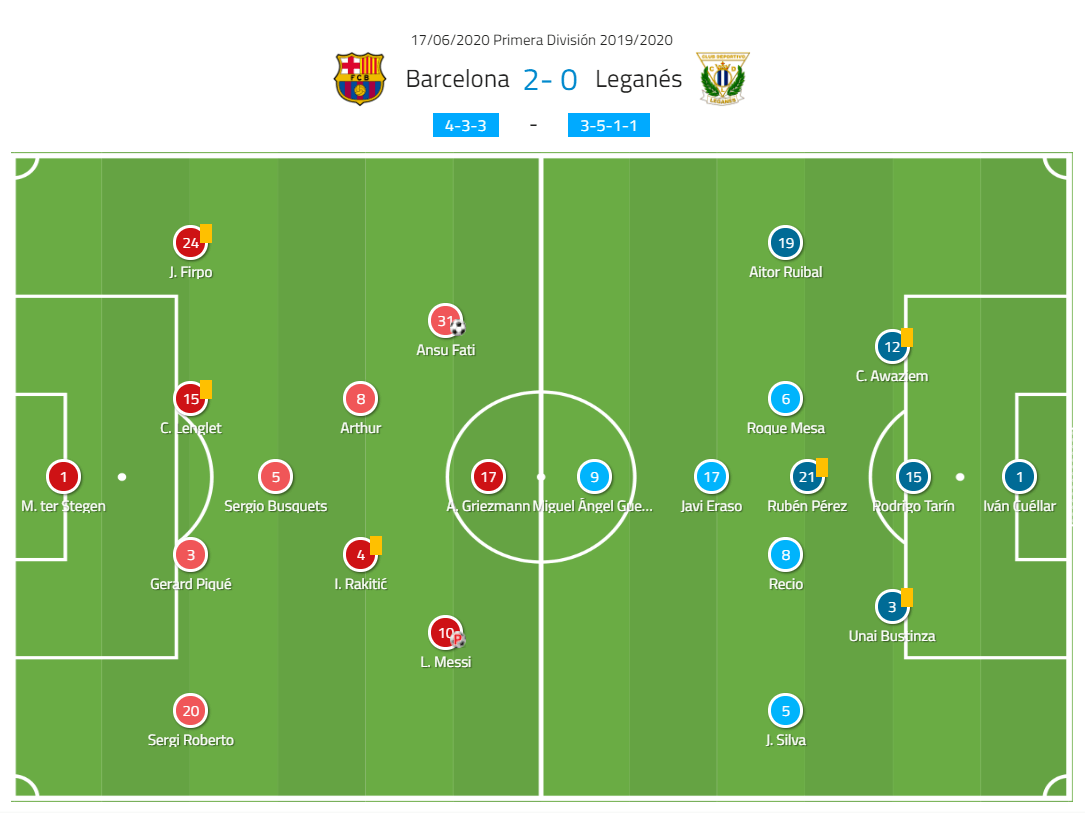
Given the high number of games until the end of La Liga, Barcelona presented some changes from their last match. In defence, Sergi Roberto and Piqué remained from the last match, Lenglet returned to the starting XI after being suspended and Junior Firpo took the left-back position in place of the suspended Jordi Alba.
In midfield, Busquets had different partners too. Ivan Rakitic and Arthur replaced Arturo Vidal and Frenkie De Jong. These rotations were motivated more by fitness than by tactics. In attack, Messi and Griezmann played along 17-year-old wonderkid Ansu Fati, who replaced the new Barcelona cult-hero Martin Braithwaite.
On the away side, Leganés made lots of changes from their loss against Real Valladolid. First, they played with five at the back, using Aitor Ruibal as the right wing-back, Bustinza as the right centre-back and Rodrigo Tarín, the new man in defence, as the middle centre-back.
From the other five players, only Roque Mesa started the previous match. Recio and Rubén Pérez formed a defensive and hard-working midfield, with Javier Eraso trying to support both the midfield and Miguel Ángel Guerrero, who was the lone striker. It’s worth mentioning only one player on the Leganés starting XI have scored this season (Mesa, one goal), showing the lack of offensive power Leganés have suffered.
Barcelona’s lack of movement
When on the ball, Barcelona formation was usually similar to a 2-5-3, with the full-backs supporting midfield and sometimes even higher, Fati starting from the left but making diagonal moves and attacking the box and Messi very close to the central part of the pitch. We can see their disposition in the picture below, with the full-backs widening the attack and the forwards working in the central area.
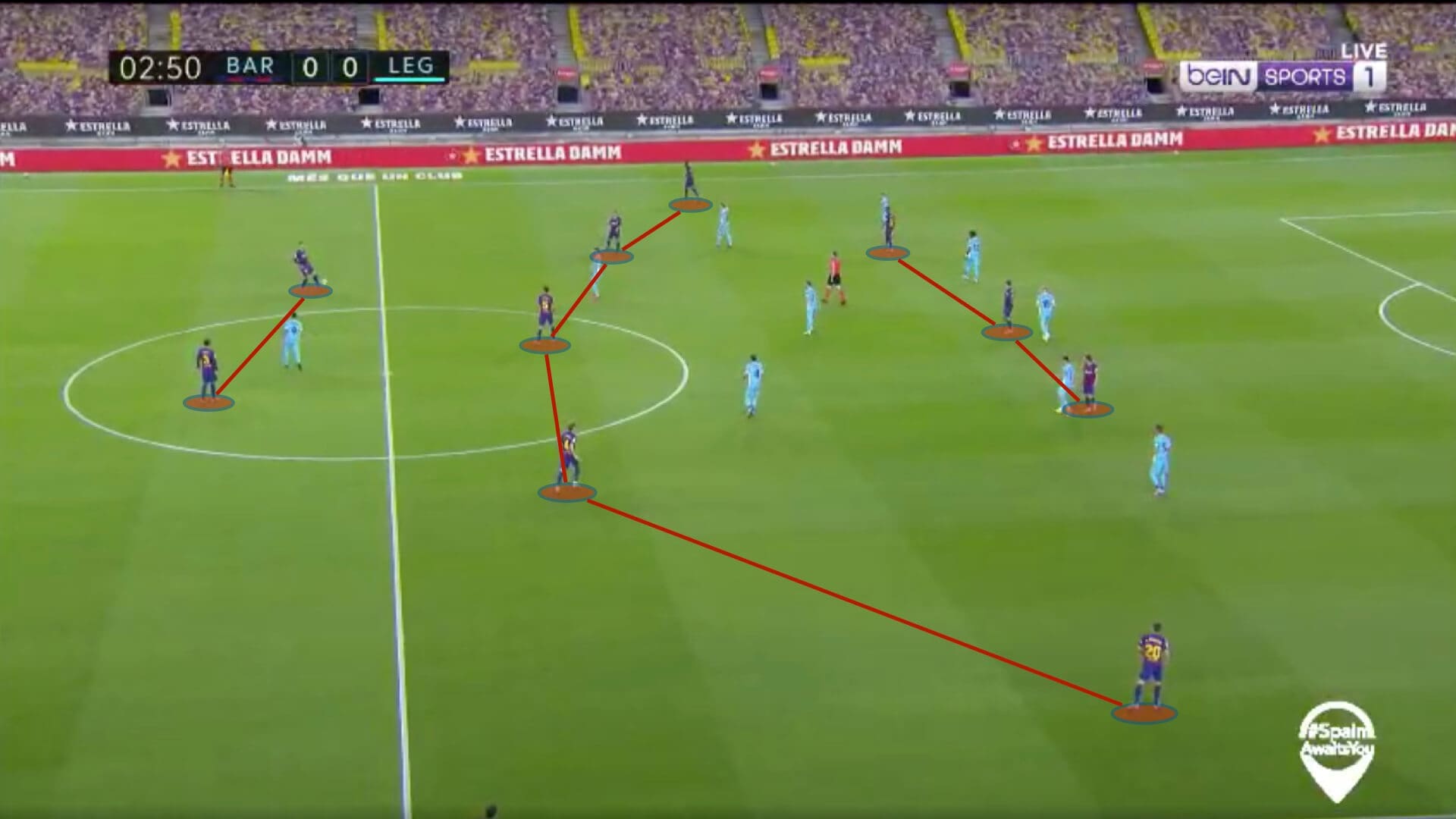
Sergi Roberto and Rakitic, the right-side full-back and central midfielder, based their movements on Messi positioning, getting more central or wide depending on where the Argentinian was in every moment. In the example below, Messi starts moving forward, so Rakitic steps back while Roberto stays by the touchline to provide width. When Messi came into midfield to take the ball, Rakitic did the opposite and attacked the defensive line.
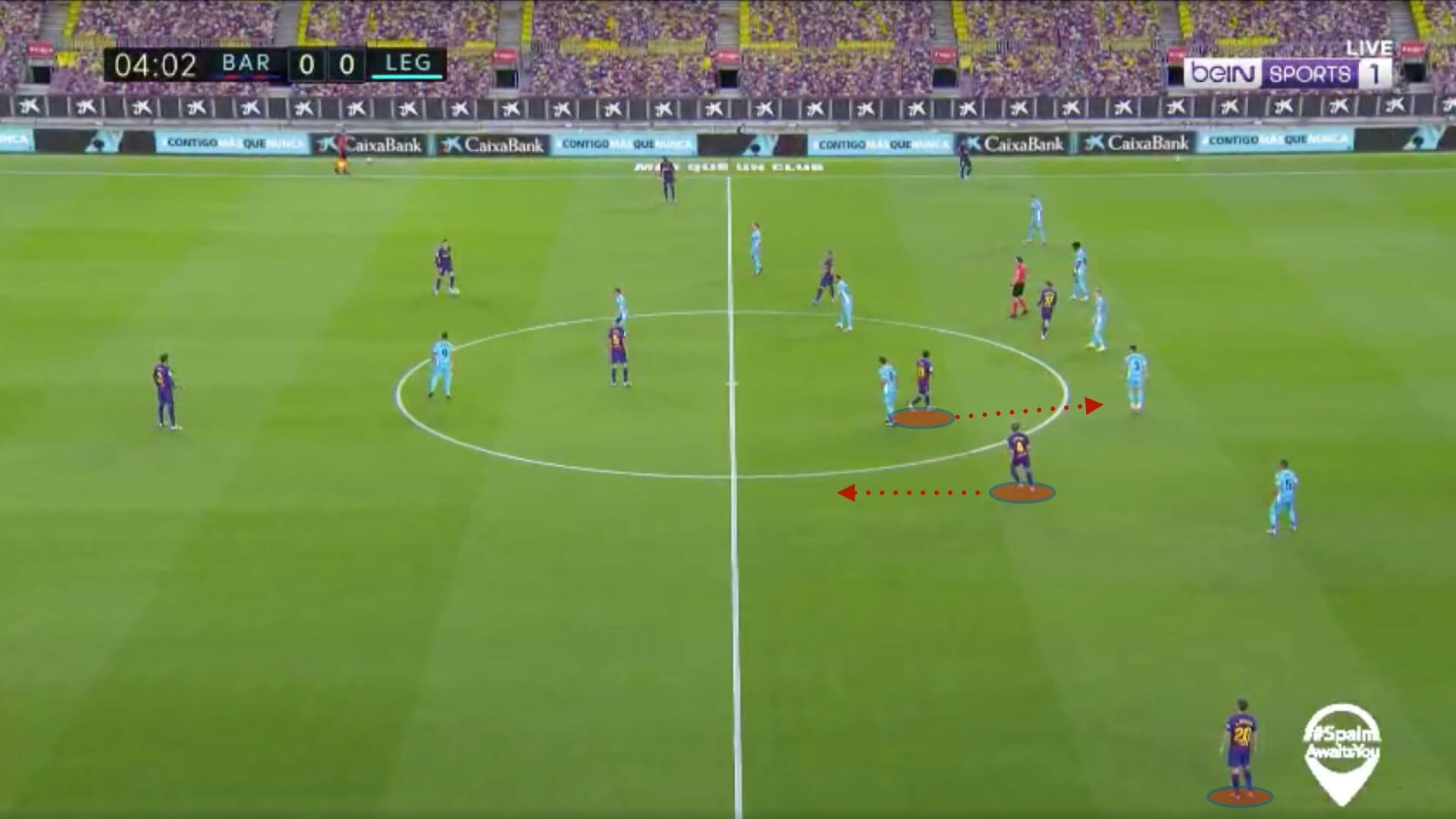
But this setup wasn’t enough for Barcelona to create danger. Of course, they had the possession most of the time, but the lack of movements in the midfield and attacking lines meant there weren’t any spaces to play in the middle, with Barcelona limiting their game to moving the ball from side to side and wait for Messi or Fati, the only two players with some dribbling ability to create something. There are two examples of this lack of dynamism below.
In this first example, Firpo receives the ball from Messi and there are only two players right in front of him: Griezmann and Fati. But both players look to receive to their feet and no one attacks the space with a run in behind, meaning he doesn’t have good options to progress. This lead to Barcelona playing from side to side and generating very few chances.
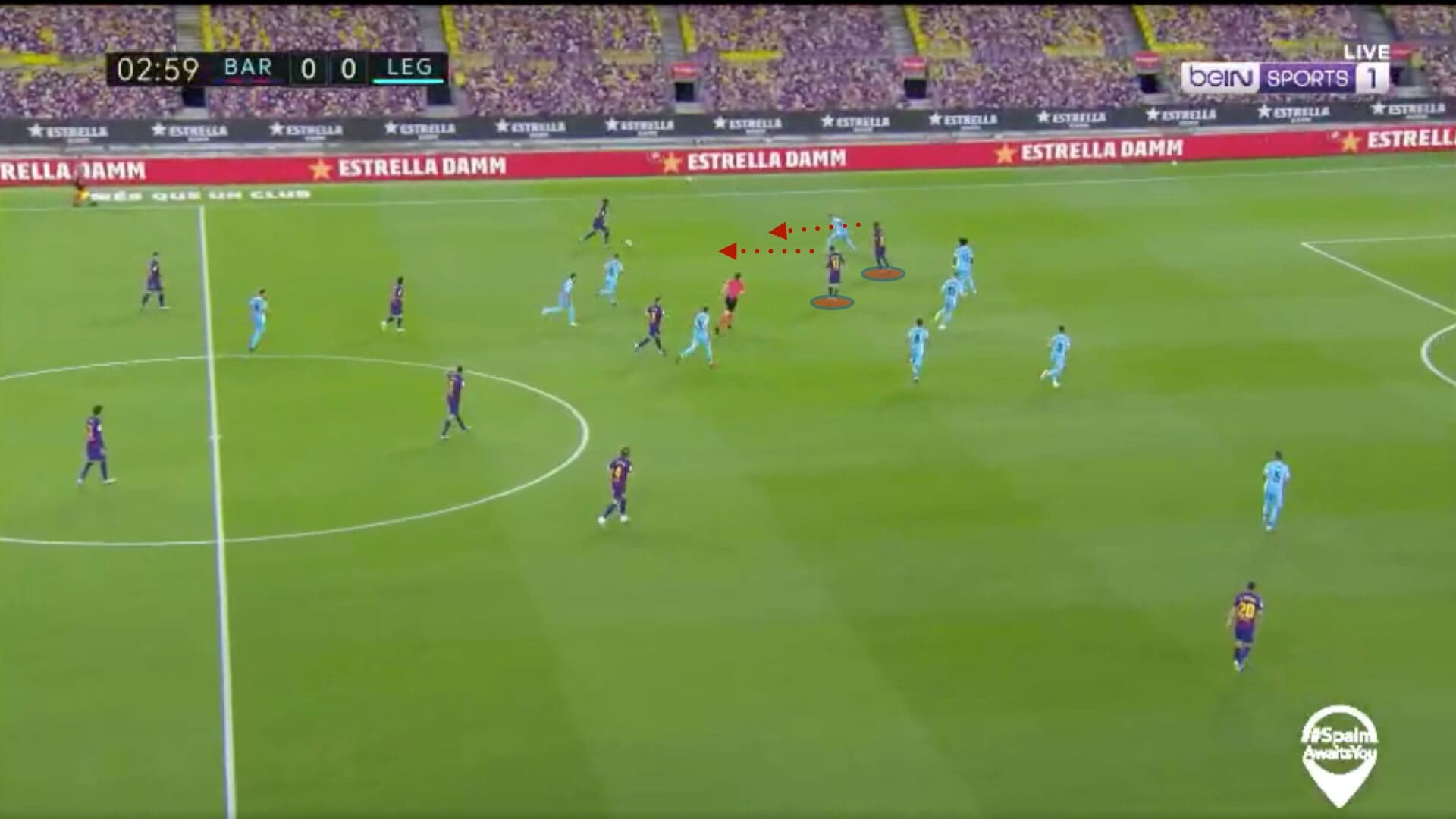
In the second example below, it’s Lenglet who has the ball, but again there’s no movement in front of him. Both Busquests and Rakitic are looking at the ball and not ready to receive and turn, while Griezmann is also moving towards the ball and not creating space with a run in behind.
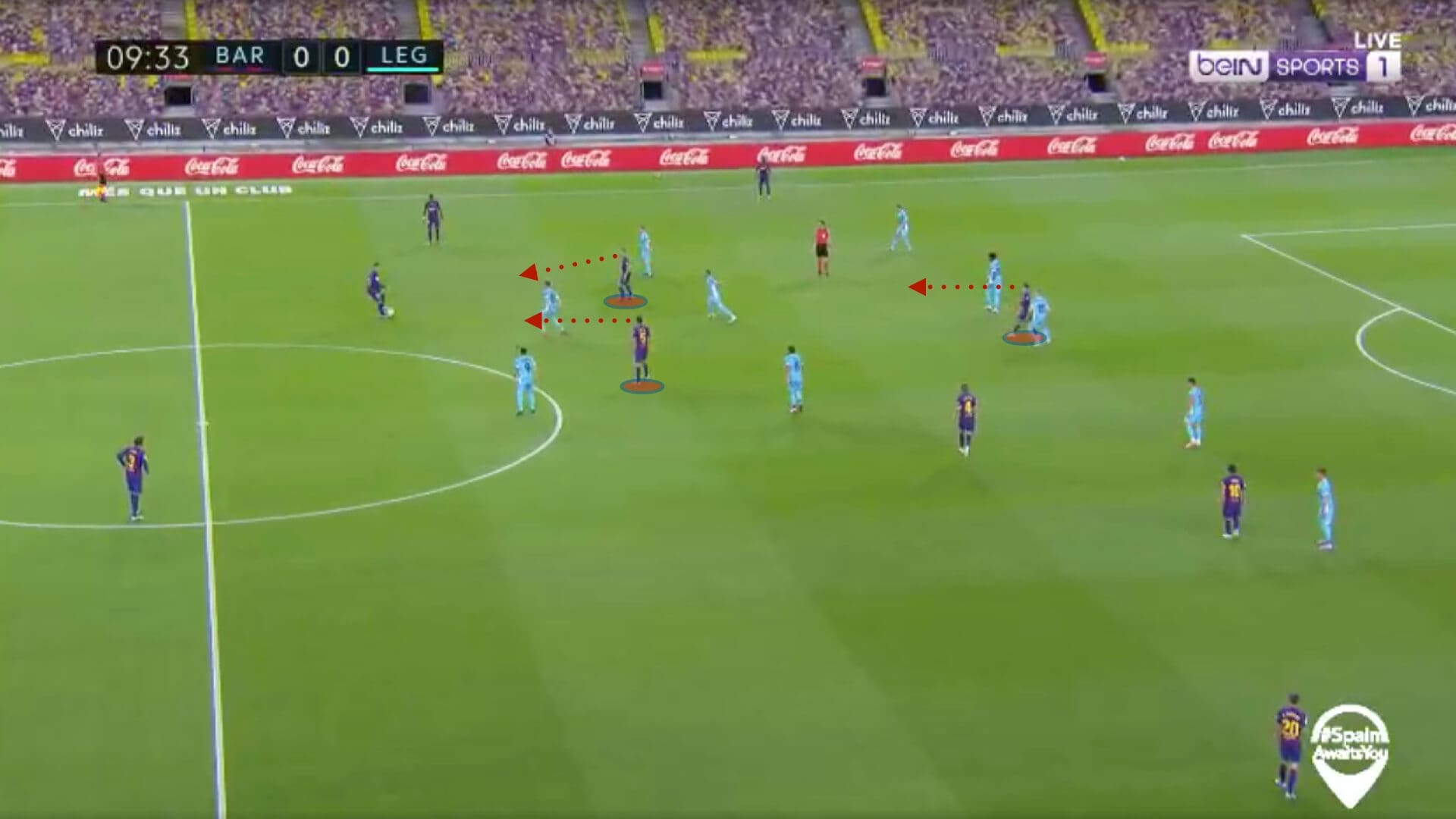
There were still some moments when Barcelona made good movements which should be the base of their development in future matches. Fati, Griezmann, Rakitic and Roberto were the most active players and showed they can move to generate spaces and make Barcelona a more threatening team. The problem was that they almost only made those good movements when Messi was in possession and the rest of the time they had the static attitude we pointed before. Only Griezmann was active most of the time, making lots of runs but being rarely noticed by his teammates, so his performance wasn’t as good as the work he put in it.
In the two pictures below, we see a first example of the good movements Barcelona was capable of making when Messi had the ball. In the first one, Rakitic made a run from midfield, dragging three Leganés’ players and creating the space for Messi to receive. The second picture happened instants after the first one. We see Messi with the ball, so Griezmann and Fati make runs in behind, dragging Leganés defenders with them and freeing up space for Firpo to receive after his late overlapping run. This shows how Barcelona players are very capable of making the right movements, but they need to make them more often.
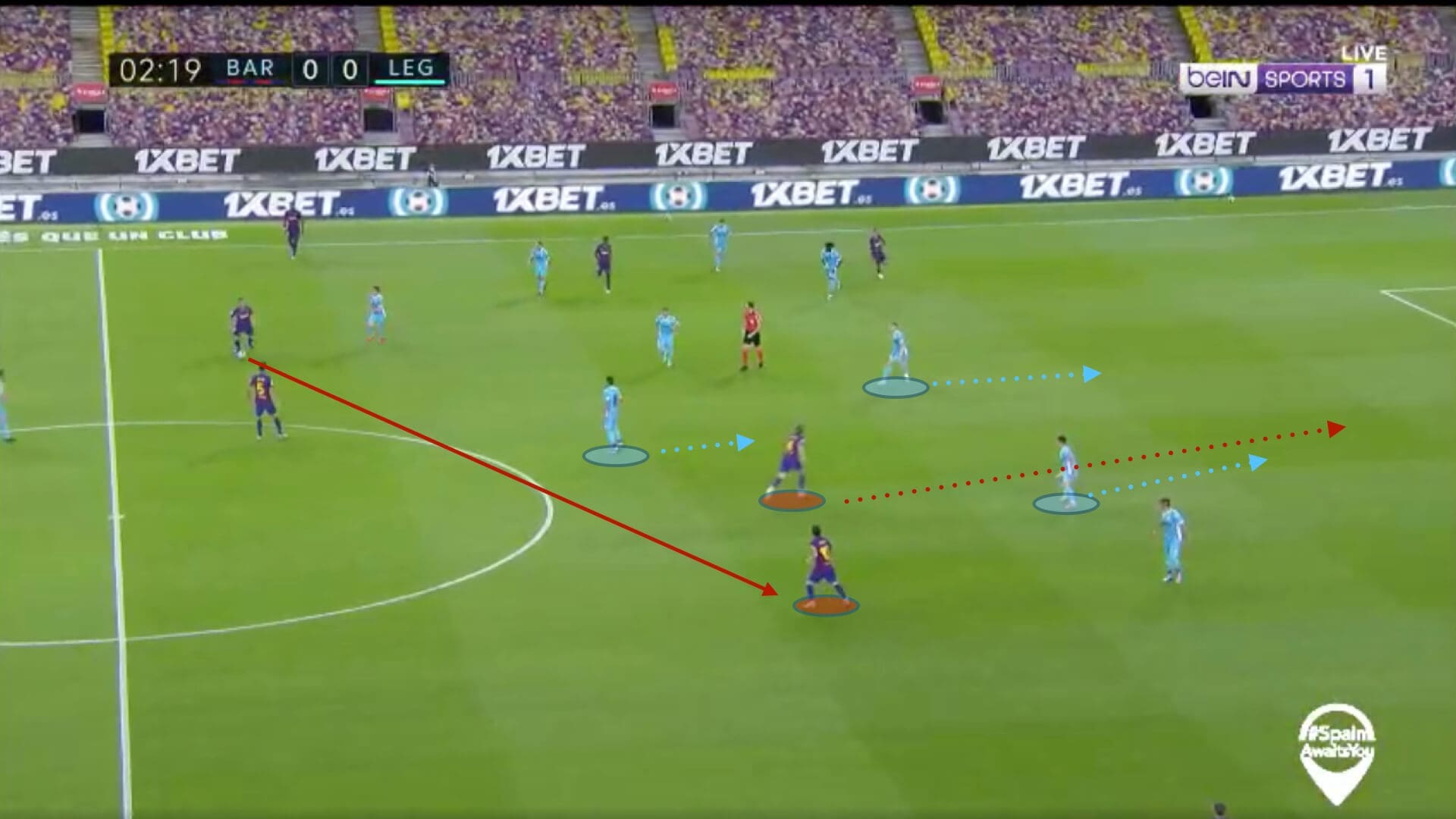
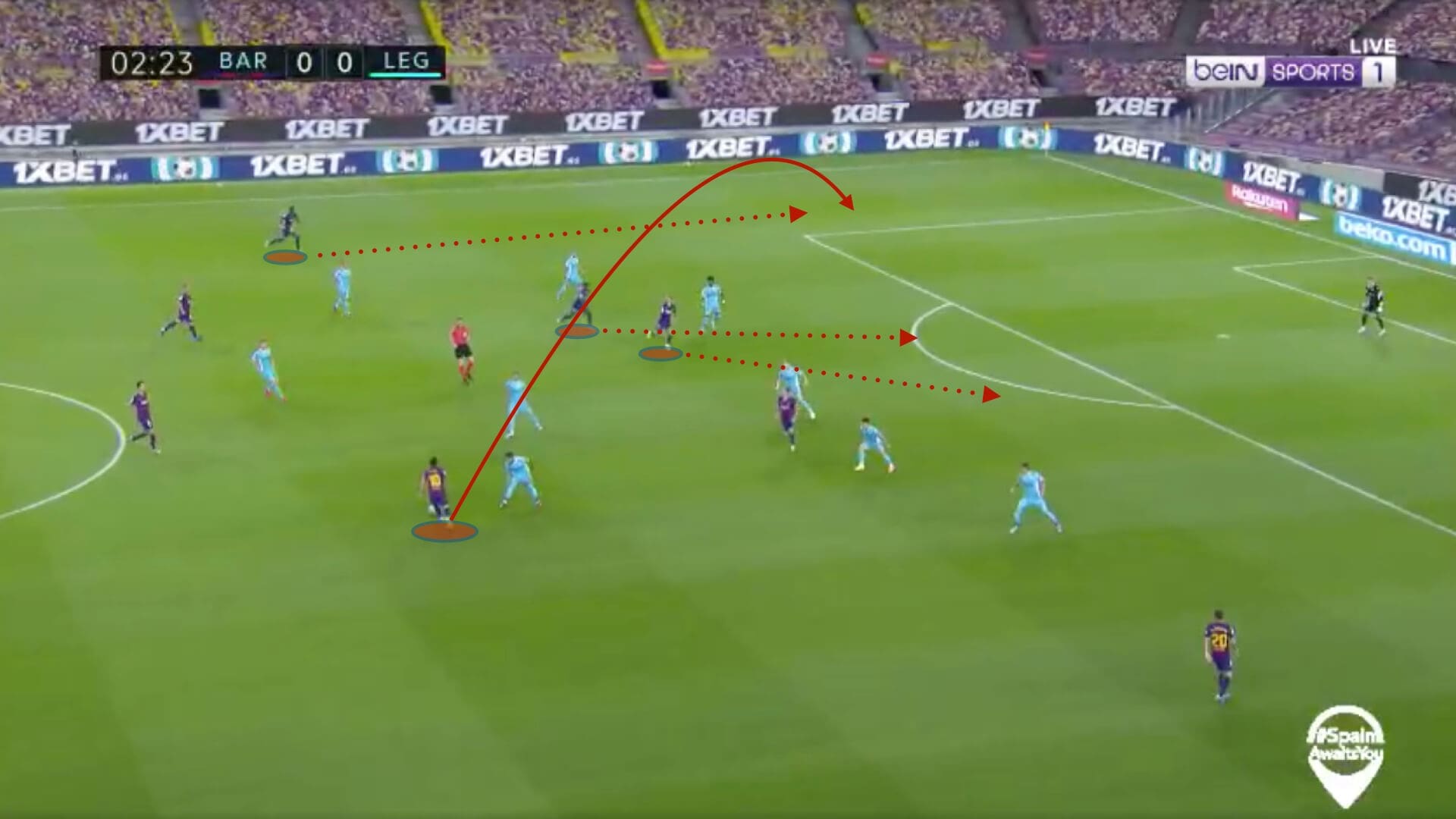
Below we can see another example of good movements from Barcelona. Again, Messi’s on the ball in midfield and four players start making runs in behind, so Leganés back three can’t follow them all. Roberto and Fati make runs on the flanks, while Rakitic and Griezmann do the same from the middle. These movements require a reaction from the opposition defensive line, generating spaces and opportunities for a fantastic passer like Messi to assist his teammates.
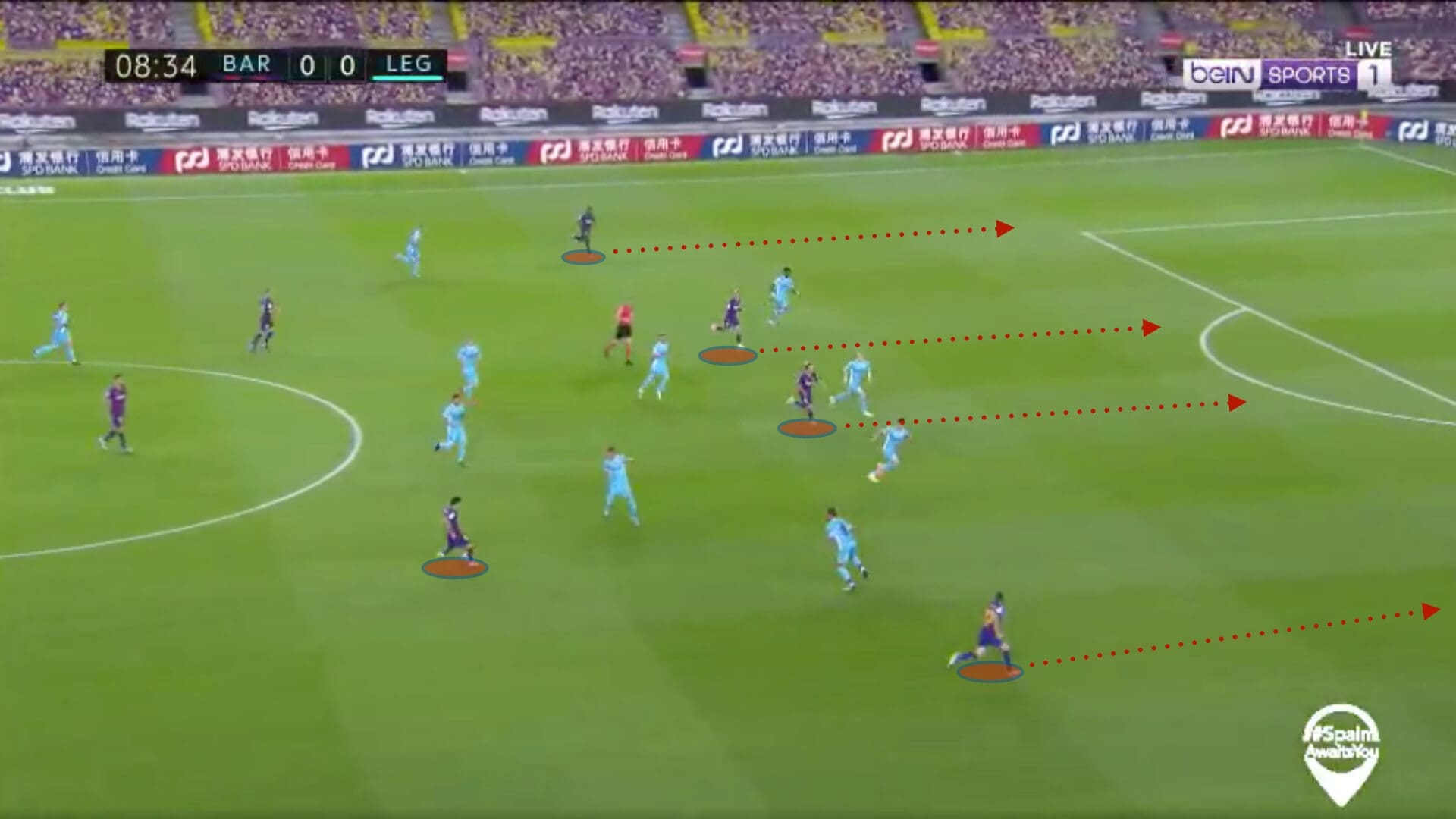
The last example of a good movement can be seen below. When Umtiti has the ball, Griezmann starts a run in behind and carries two defenders with him, creating some space in front of the defensive line. Arthur runs towards Umtiti instead of taking advantage of the space, and when Umtiti passes the ball to Firpo there’s no one in a position to receive between the lines (the yellow arrow represents the pass Arthur should have received). This is a clear example of Arthur not understanding the third-man concept and trying to receive the pass directly instead of using a teammate to bypass the pressure and receive in a better position.
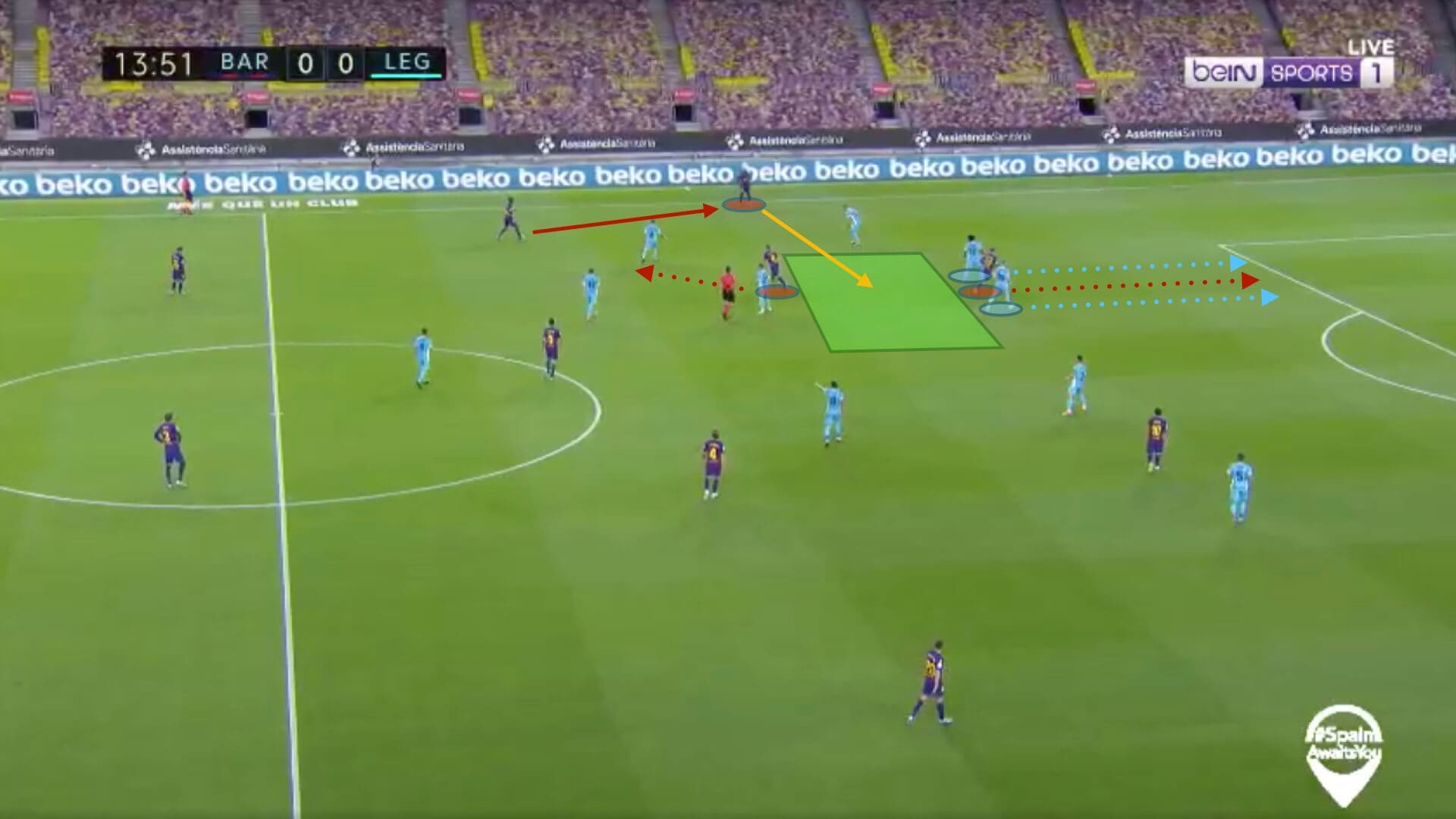
As a summary, Barcelona showed some promising signs of good attacking movements but didn’t do it often enough to be a threatening side, ending up having possession for a very long period but not creating a lot. Actually, both goals came from isolated plays, the first one from a great shot by Fati after some rebounds and the second from a penalty kick Messi scored after provoking the foul after a great solo run. A 76% possession with 849 passes only translated to 20 passes into the penalty area, so it was mostly a slow lateral-passing game.
In defence, Barcelona’s pressure was very good for most of the game (only 5.5 PPDA), but the few times it didn’t work the defensive line felt too isolated and fragile. They conceded 1.45 xG, and Leganés enjoyed the best opportunities in the game. As a comparison, Barcelona generated 1.61 xG, and that’s counting 0.76 xG from Messi’s penalty kick, so we could assume Barcelona could have had a much worse result against a more clinical team.
Leganés defensive setup
Leganés used a very defensive approach at the Camp Nou and it could have paid off. Their formation was a 5-3-1-1 in defence, with the right wing-back Ruibal, a natural winger or striker, moving forward to support the attack when he could.
They focused on being very compact, leaving the flanks free and making it very difficult for Barcelona to penetrate through the middle. But being defensive didn’t mean defending very deep for Leganés. They tried to advance whenever Barcelona played backwards, with their lines very close all the time and no space to play between them.
We can see Leganés’ defensive disposition in the picture below. The 5-3-1-1 formation is clearly seen, with someone marking Busquets all the time and focusing on keeping a compact shape but not retreating too deep if possible. This made Barcelona very uncomfortable, and only Fati and Messi could create spaces in the defensive setup using their dribbling abilities.
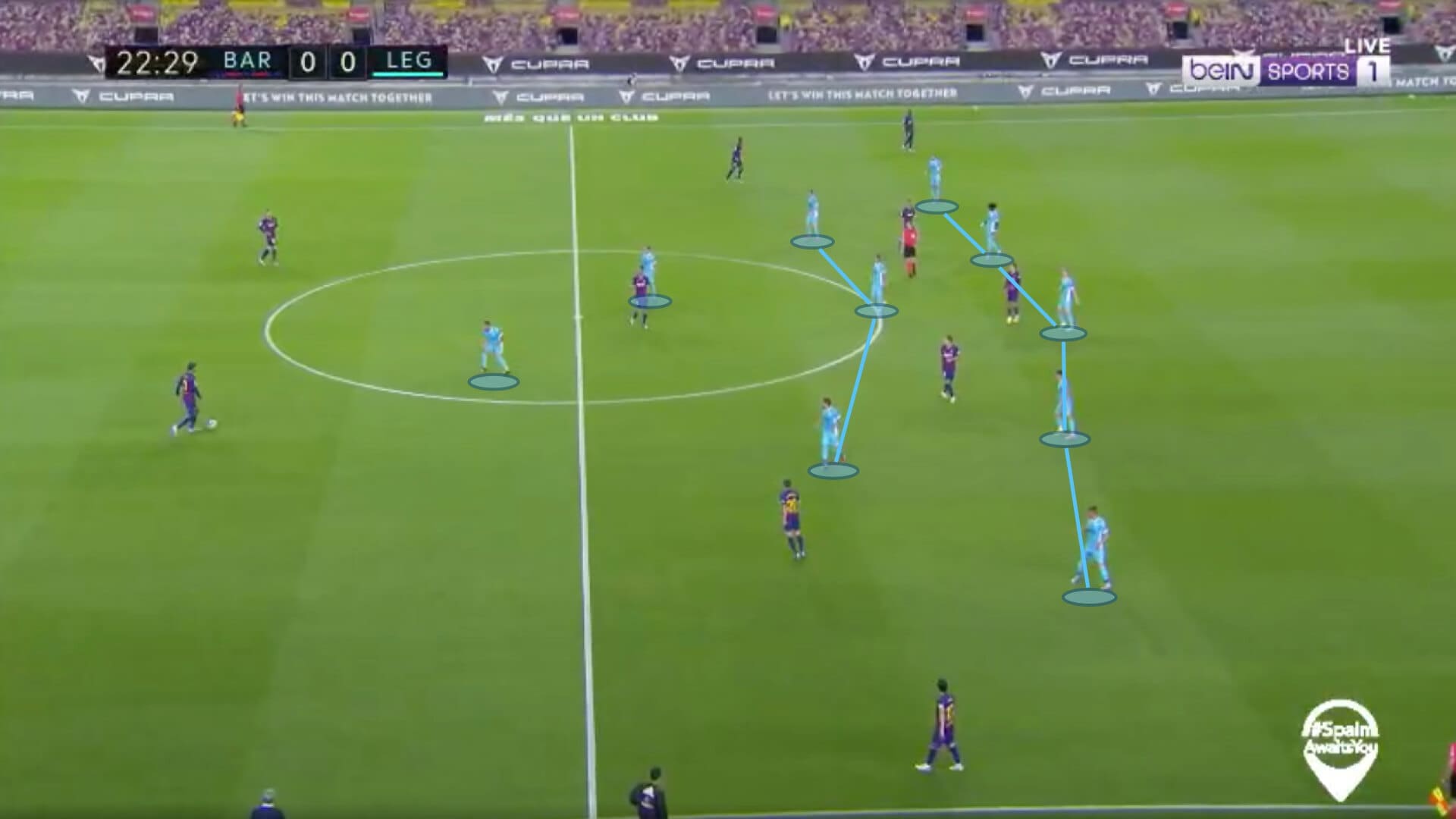
Even if they went to the Camp Nou to defend, Leganés had some good chances to score. They used a very direct approach in the attacking phase, trying to force mistakes in Barcelona’s defence and taking advantage of them. Their clearest chance came from the huge defensive mistakes from Barcelona we see below. The play comes from a direct ball that was headed back into Leganés’ half. Then, Barcelona’s defensive line tried to advance and leave Leganés’ forwards offside, but the movement was very badly coordinated and they left huge spaces to be exploited with an easy long pass.
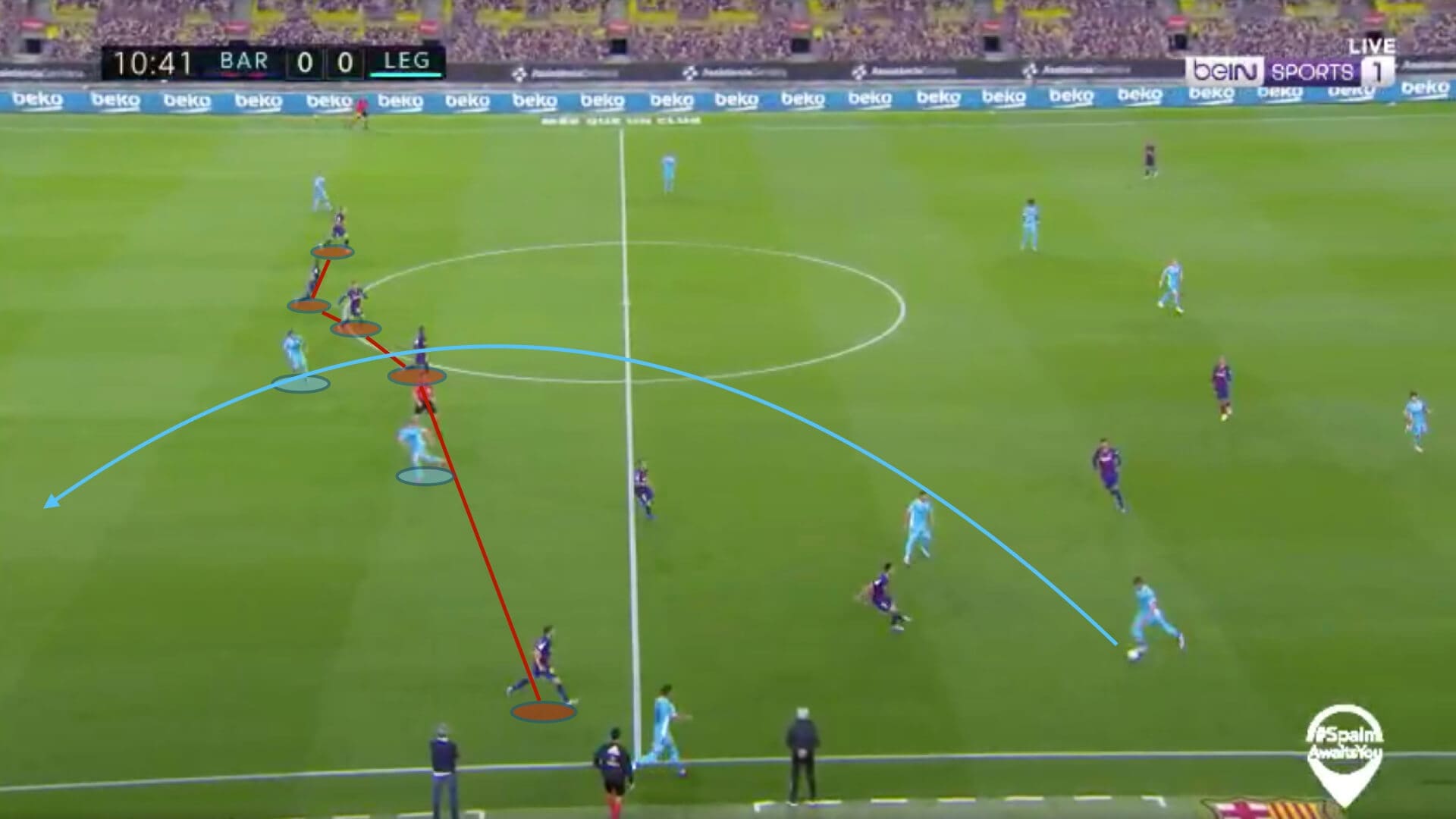
Another weakness Leganés looked to exploit was Busquets. The Catalan midfielder is still one of the best in his position, but he’s no longer able to turn quickly or cover big spaces, so Leganés took advantage of how high Arthur and Rakitic were positioned to attack the spaces on both sides of Busquets.
In the example below, Busquests tries to press the man in possession but doesn’t do it quickly enough and allows a pass. At the same time, Rakitic doesn’t track back on time and leaves a player unmarked and a two-vs-one situation on the left side of Leganés’ attack. The play ends up in a weak shot, but it could have meant the draw for Leganés.
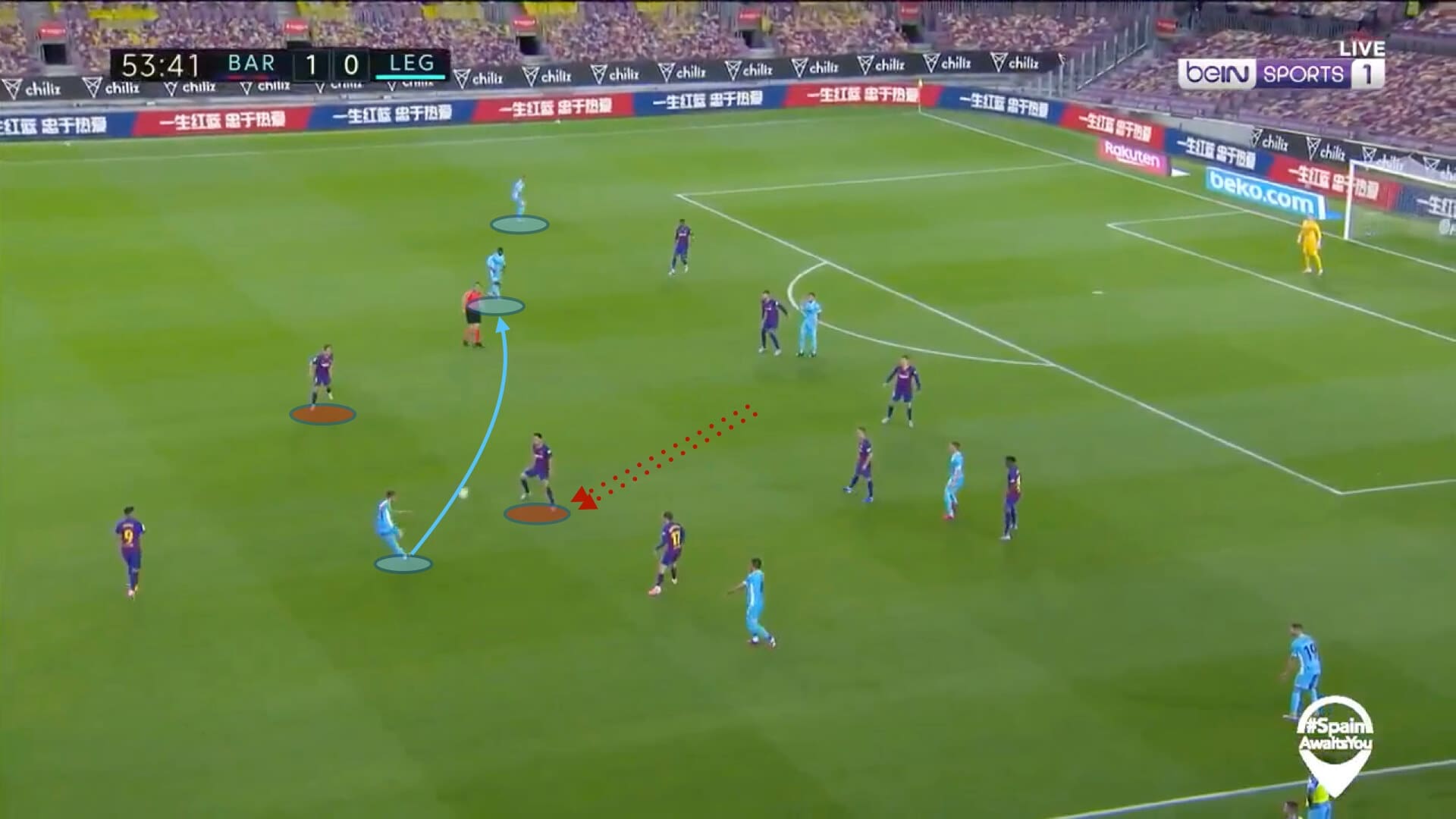
As we said at the end of Barcelona’s attacking analysis, they were somehow lucky to score twice, and both goals were moments of individual brilliance rather than good team plays. So Leganés has a lot of positive things to take from the match except the one they needed the most: the result. Leganés generated the best chances and registered only two shots less than Barcelona with a ball possession of only 24%.
The role of the substitutions
With the new rules allowing up to five substitutions, it’s always interesting to see how they affected the game. We will focus on Barcelona’s subs as Leganés didn’t change a lot and they just looked to replace tired players to bring fresher ones in.
The first two changes for Barcelona were Luis Suárez for Fati and Nélson Semedo for Roberto. Suárez wasn’t a big change but provided more presence in the striker position, holding the ball and combining with his teammates who arrived from behind. He also let Griezmann move with more freedom.
Semedo also offered different things from Sergi Roberto. While the Spanish understood and balanced Messi’s movements and moved between the right side of midfield and the right-wing, Semedo acted mostly close to the touchline, using his pace to rush up and down. His speed allowed him to get in behind and Messi could find this runs with his precise passing.
In fact, Semedo’s pace was enough to generate a goal. He made a direct run and Messi found him with a good deep pass. Semedo’s cross found Griezmann and the Frenchman scored, but it was disallowed by the VAR because Semedo was millimetrically offside at the beginning of the play. Even if the goal didn’t stand, it was an example of what Semedo can contribute to his team, and also of how important Griezmann’s moves can be when correctly interpreted. We can see the play in the picture below.
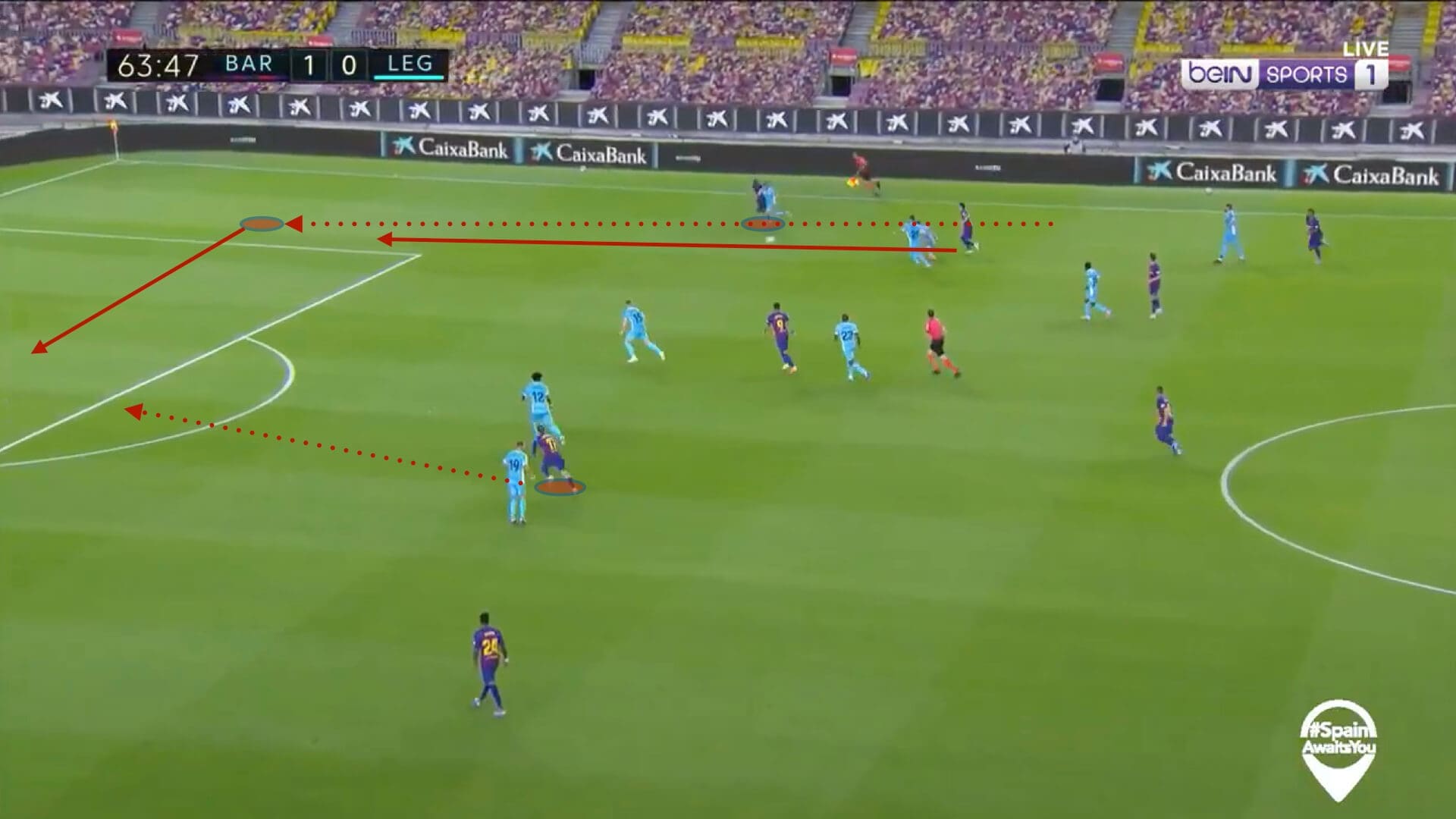
Another interesting change was Arturo Vidal for Busquets. The Chilean moved Rakitic to the defensive midfielder position, from where the Croatian feels more comfortable as he doesn’t need to turn with the ball and can play with all the field in front of him. Arthur stepped back too, dictating from a deeper position and using the movements in front of him to progress the ball more effectively before being substituted by Riqui Puig, who took a more advanced role again. Vidal entered the game and used his energy to attack spaces, recover the ball higher up the pitch than before. His movements combined with Semedo’s runs and Leganés’ openness generated more spaces than before for Messi and Puig to play in.
Puig was quite active in the 20 minutes he played too, showing he has the quality to play for Barcelona. His stats tell us more about his performance. In just 20 minutes, Puig shot twice (total of 0.23 xG, with the clearest Barcelona chance in the game); he tried 11 passes with a 91% success rate; worked hard in defence and got involved in five defensive duels, winning 40% of them. He also showed his pace to drive the ball forward and didn’t feel the pressure of playing in La Liga, so it was a very good 20 minutes for him.
Conclusion
A match between the first and the last is always going to be an unbalanced one. However, Leganés defensive setup was quite solid and only a couple of moments of magic managed to break it. On the other side, Barcelona suffered much more than one could expect and conceded a lot of dangerous shots, which amounted to 1.45 xG. Those opportunities were more a matter of individual mistakes but they would have been much more costly against any other teams.
Going forward, Leganés can take away positive things from this loss, as they defended well and were able to generate a lot given the circumstances. They desperately need to be more clinical in front of the goal if they want to have any chance of avoiding relegation, but it was a good performance against the best team in the league. Barcelona can also take positive things away but they need to be much more consistent both in their attacking and defensive movements as their playing style require a whole-team effort and any failure leaves them very open and fragile. This time it was enough to maintain their advantage over Real Madrid, but they should improve if they want to win the league.


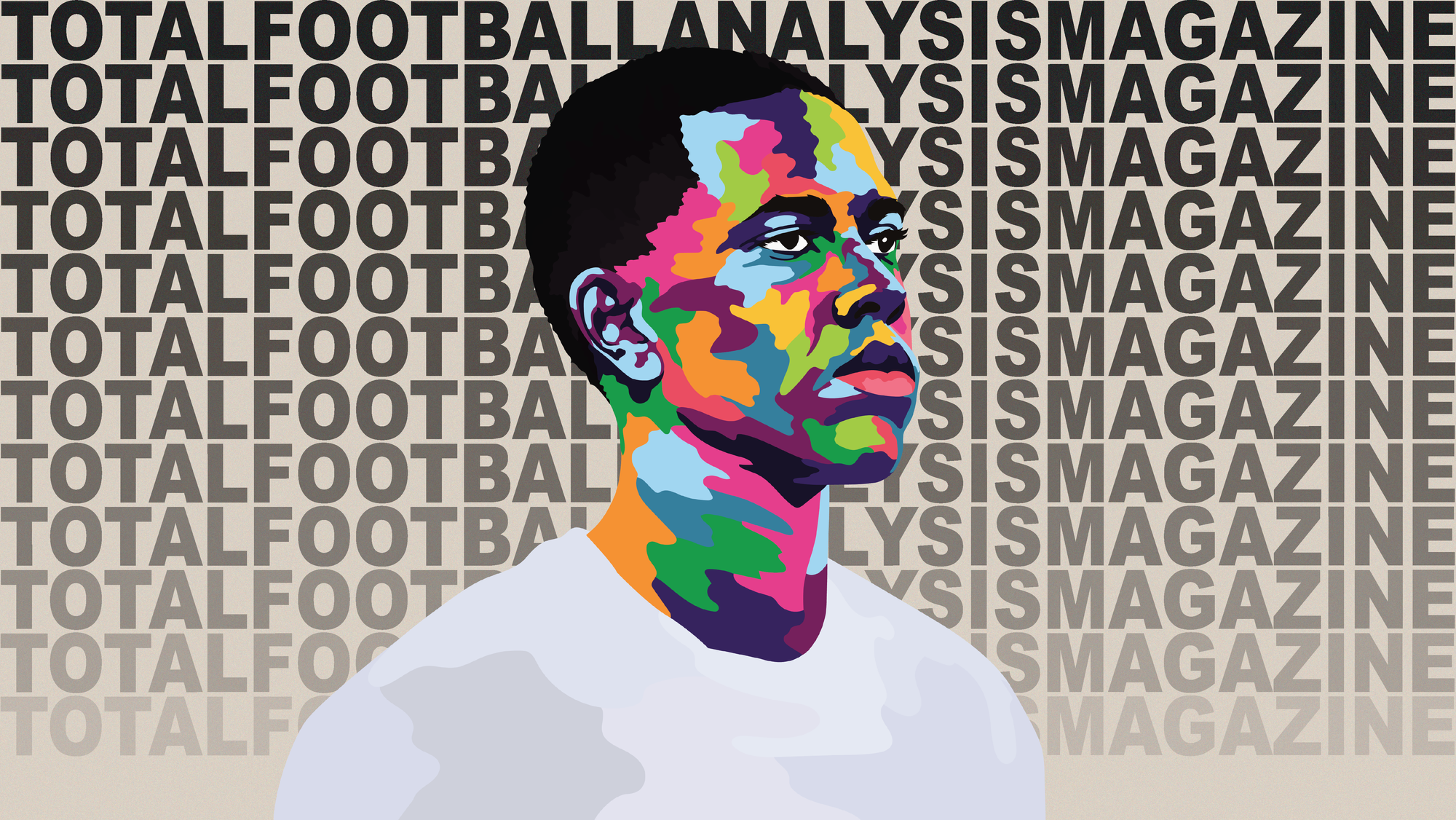

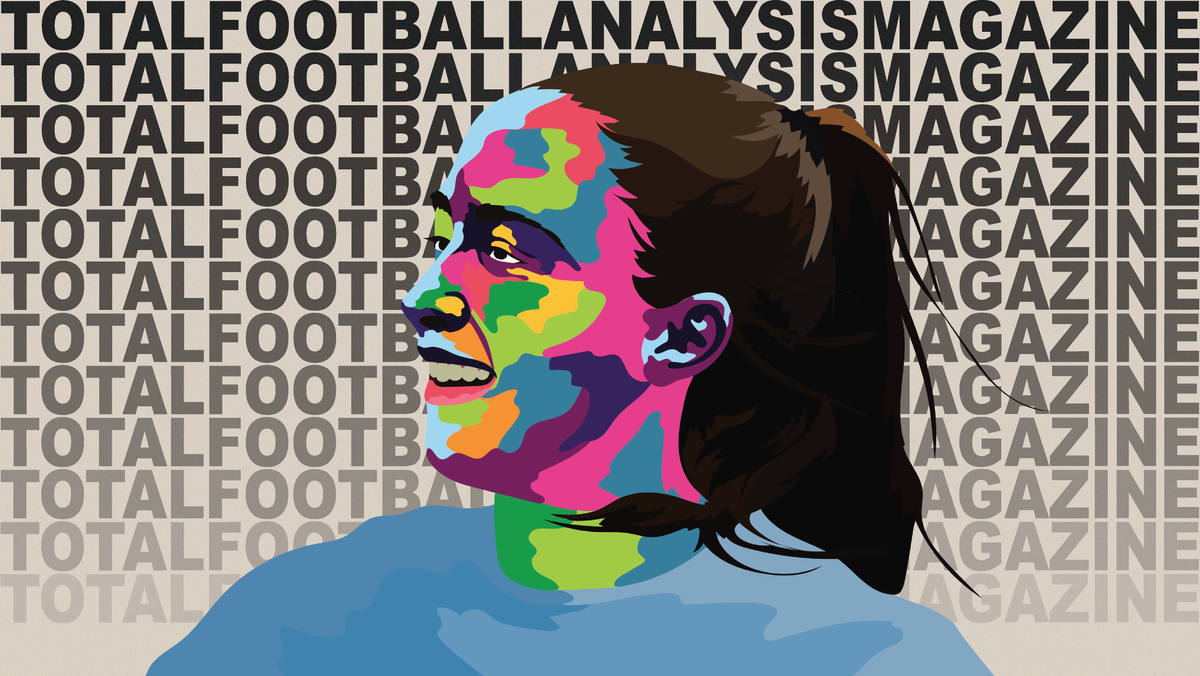
Comments